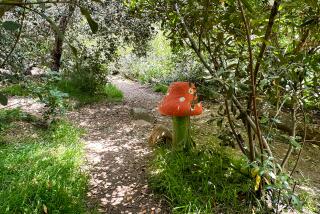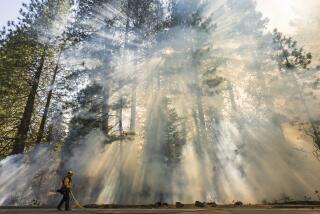Don’t rush to reseed at park, experts say
Several scientists are cautioning Los Angeles officials to think hard before reseeding and replanting large areas of Griffith Park that burned in last week’s 820-acre brush fire.
Reseeding can be expensive and potentially useless, said the scientists, who specialize in restoring open land in Southern California after major wildfires. It can also introduce grasses and other plants that normally do not grow in the region, crowding out natural vegetation, they said.
“It’s generally a waste of money,” said Jon E. Keeley, a research ecologist with the U.S. Geological Survey who has written extensively about fire ecology. “There are countless examples in Southern California where people have spent millions of dollars on these projects, and it’s just been a complete waste.”
Even as the last smoke cleared from above Griffith Park, debate emerged over the best way to restore one of the nation’s largest and best-known urban landscapes. In a region accustomed to wildfires, a large blaze in a highly popular park poses new challenges as the city begins to grapple with satisfying the sometimes conflicting wishes of residents, scientists, environmentalists, picnickers, golfers and hikers.
Some city officials said Sunday that they had not approved a major reseeding program, despite Friday’s announcement of a preliminary $50-million emergency plan that would use reseeding to prevent erosion and mudslides on hillsides left denuded by the fire.
“We don’t have a reseeding program yet,” said Jon Kirk Mukri, general manager of the city’s Recreation and Parks Department. “Anything we do within the park has to fit in with the ecosystem.”
A spokesman for Mayor Antonio Villaraigosa said Sunday afternoon that plans were still being developed and that Villaraigosa had not taken a position on any of the possible ways to rehabilitate the 4,200-acre park.
“The mayor has made clear that the park will be restored as quickly as possible using the cutting edge of science,” said spokesman Matt Szabo.
City Councilman Tom LaBonge, whose district includes the park, said he worries that if hillsides are left barren, rains next winter could trigger major mudslides. Areas such as Vermont Canyon could be especially slide-prone in heavy rains, he said.
LaBonge has not ruled out some reseeding as well as replacing nonnative trees that grew in popular hiking areas such as Dante’s View and Captain’s Roost.
“There are some purists that will preach only natives,” he said Sunday. “I’m not afraid of nonnatives. Los Angeles is a nonnative city.”
With Villaraigosa’s approval, he added, he would like to use a small portion of the $100,000 donated for restoration by Dodgers owners Frank and Jamie McCourt to restore Dante’s View and Captain’s Roost.
Park rangers on Thursday said they wanted to swiftly replant and reseed burned areas to fend off rainy season landslides that could harm park facilities and Los Feliz homes. That has stirred concerns among some restoration experts who said the city might do better using hay bales and rice straw mulch to guard against landslides.
Reseeding, they said, is an outmoded and unscientific approach.
“There is no doubt in the scientific community now. They’re overwhelmingly against this approach to dealing with the post-fire environment,” said biologist Richard W. Halsey, director of the California Chaparral Institute, an Escondido-based research group.
Jan L. Beyers, a plant ecologist with the U.S. Forest Service’s Pacific Southwest Research Station, said she worked on reseeding studies in the Santa Monica and Santa Ana mountains and near Santa Barbara.
“What we found on five study sites is no reduction in erosion in the first two years after a fire,” Beyers said. In fact, the chaparral plants of the type common in Griffith Park usually rebound successfully on their own after a fire, she said.
Land managers traditionally used aircraft to spread grass seed over burned areas to hold soil in place until native plants were reestablished.
That practice has been criticized in recent years by scientists who said that the nonnative grasses can overpower the native plants, including so-called fire followers, the wildflowers and other plants that sprout only after wildfires. To make matters worse, the seeded grasses that dry up in the hot Southwest summers can fuel wildfires more effectively than native shrubs.
Seeding has been more successful in the Pacific Northwest, where seeds can germinate in light autumn rains and heavy rains do not arrive until later in the season, Keeley said. But the rainy season in Southern California usually starts with heavy precipitation that can wash seeds off hillsides.
When the seed mix does sprout, it sometimes is found to contain seeds of nonnative plants that can create headaches for farmers and ranchers. Seed spread aerially after a 2000 wildfire near Los Alamos, N.M., was later found to contain an estimated 1 billion seeds of cheatgrass, a Mediterranean grass that invades western prairies, harms rangeland and fuels fires.
deborah.schoch@latimes.com
More to Read
Sign up for Essential California
The most important California stories and recommendations in your inbox every morning.
You may occasionally receive promotional content from the Los Angeles Times.










